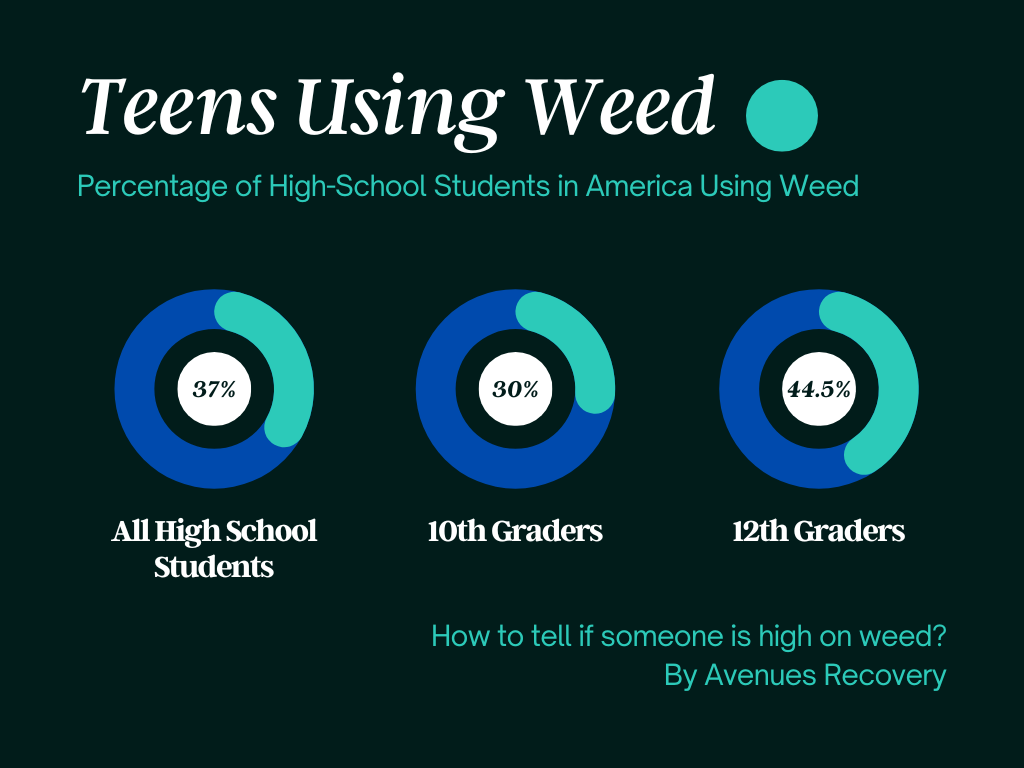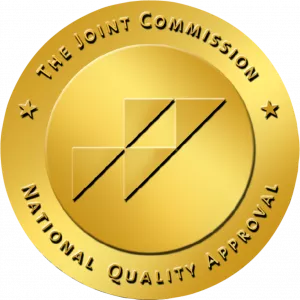Wondering how to tell if someone is high on weed? Recognizing the signs is crucial in today's marijuana-friendly landscape. Join Avenues Recovery, a trusted rehab resource, to explore the common behaviors associated with marijuana use, understand how people act when high, and what a high person looks like.
What is Marijuana?
The term Marijuana (also known as Weed and Pot) refers to the dehydrated flowers, leaves, stems, and seeds of the cannabis plant, which naturally contains the psychoactive chemical delta-9- tetrahydrocannabinol (THC). There are 3 main categories of marijuana: Indica, Sativa, and Hybrid- a mixture of both. It is available in numerous forms, including but not limited to cigarettes, edibles, vape oils (E-cigarettes), body lotions, transdermal patches, and capsules. Its chemical components cause a pleasant sense of euphoria and calm.
Explosion in Marijuana Use and Abuse
Marijuana is considered less potent than many other psychoactive drugs, which has caused it to be widely used and abused. Many adolescents and young adults (mistakenly) view weed use as a pleasurable and harmless pastime and addiction rates have skyrocketed in recent years. Additionally, countless states have begun legalizing recreational marijuana, merely exacerbating an already problematic situation. 33 states allow medical marijuana with reduced penalties for possession, and 18 states have entirely legalized recreational marijuana use.
Percentage of Adolescents Using Marijuana
Although marijuana use for those below 21 years of age is not legal anywhere in the US, teenage use of weed is at its highest point in 30 years, with teens even more likely to smoke weed than commonplace tobacco. Recent studies reported that over 37% of American high school students use weed, with 22% admitting to using it within the past month. The older a teen is, the higher the likelihood that they have experimented with marijuana – evidenced by the statistic that the number of marijuana users grows from 30% of tenth graders to 44.5% of all seniors.

Benefits of Early Detection and Intervention
Overuse and abuse of marijuana can have numerous negative effects on both body and mind. This is especially true when used by adolescents, whose minds are still in the critical process of maturing, and on whom its long-term effects can be debilitating. Marijuana interferes directly with brain development and specifically affects areas responsible for rational decision-making, reward-seeking, and basic impulse control.
Understanding how to tell if someone is high and awareness of the signs and symptoms of abuse is key to early detection and intervention. The sooner one can determine problematic use of marijuana- in oneself or others, and understand how to know if you’re high- the sooner professional intervention can be sought, and the more damage can hopefully be avoided. Another risk of marijuana use and the benefit of early intervention is the issue of fentanyl-laced weed. Ingesting even a drop of fentanyl can be lethal for those who are not tolerant.
Marijuana Abuse: Symptoms of Being High on Weed
Marijuana has a wide variety of symptoms and effects - whether physical, cognitive, emotional, or psychological. Below is a list of the most common symptoms of getting high on weed
Physical Symptoms
Physical signs of being high include:
- High blood pressure
- Increased heart rate
- Increased rate of breathing
- Bloodshot eyes
- Shrunken pupils
- Dry mouth
- Unusual appetite
- Unusual drowsiness and fatigue
- Difficulty with motor coordination
- Weight gain
Cognitive Symptoms
Cognitive signs of being high include:
- Decreased reaction time
- Slowed reflexes
- Impaired judgment
- Distorted sensory perceptions
- Distorted sense of time
- Superstitious thoughts
- Short-term memory loss
Emotional/ Psychological Symptoms
Emotional and psychological symptoms include:
- Heightened sense of pleasure and euphoria
- Giddiness
- Mood swings
- Sudden depression
- Sudden anxiety, paranoia, and/ or panic
- Personality changes
- Suicidal thoughts
- Lack of motivation
It is important to note that the signs and effects of marijuana can vary widely from individual to individual, based on many factors – including but not limited to genetics, age, history of use, concentration of the drug, and amount ingested. Noticing any signs someone is high on weed or a combination of the symptoms described above in an individual does not indicate a definite diagnosis, but a likelihood that they are using this drug.
Signs of Marijuana Use and Abuse in Adolescents
In addition to its medical aspect, there are various paraphernalia, distinct behaviors, and side effects that accompany a problematic habit of weed use. If you suspect your teen or loved one is using marijuana, keep a sharp eye out for any of the items or behaviors described below.
Paraphernalia
Some common paraphernalia used for consuming marijuana include:
Rolling papers - Thin, lightweight cigarette papers are used to roll weed into smokable cigarettes, or “joints”.
Bongs - Bongs, also known as water pipes, are made of either plastic or glass and are used to vaporize and smoke weed. Bongs come in all sizes.
Pipes – These smaller, more portable pipes are also used to smoke weed, and have a visible cavity where the drug is placed.
Roach clips – Small metal tweezer-like clips are often used by weed smokers to grip their cigarettes, enabling them to smoke their joint to the very end without burning their fingers.
Vaporizers – Vaporizers or “vapes” (which look much like ordinary nicotine vaporizers), can also be used to smoke weed in a more concentrated wax form.
Edibles - There is now a wide variety of THC-rich edibles, such as brownies, cookies, and candies, which are easily procurable and provide the same “high” as any other form of weed.
Visine – Many weed-using teens use eyedrops to conceal their bloodshot eyes, which is an unavoidable side effect of marijuana use. Normal, healthy adolescents generally do not need corrective eye medication.
Incense/ Scented Candles/ Air Fresheners – Another common and ingenious tactic used to conceal weed abuse is the use of incense, scented candles, and other forms of air freshener to overpower the distinct, “skunk-like” smell of the drug.
Mouthwash/ Breath Strips/ Perfumes/ Deodorants Savvy weed users will utilize all sorts of scent-masking agents to conceal the stink of the drug on themselves as well.
Marijuana-Related Posters/ Memorabilia – Marijuana is not only an unhealthy pastime but a glorified culture among many teens. Discovering weed-related posters, stickers, pins, and badges among your child’s possessions indicates a problematic interest in the drug. (The code “420” refers to weed smoking, and can often be seen on posters, pins, and bookbags.)
Behaviors
How do high people act? Some common behaviors when consuming marijuana include:
Sudden lethargy, confusion, and memory loss – Marijuana affects many things, including working and short-term memory, and energy levels. If your teen seems inexplicably exhausted and disoriented or has difficulty conducting a normal conversation (constantly losing focus and drifting into other topics), he/she may likely be high on marijuana.
Drop in academic performance -When an individual becomes dependent on a drug, all energies and resources are channeled to support their habit. If your previously hardworking, straight-A teen is turning out C’s and D’s, there may be room for concern.
Loss of all interest and motivation - If your child seems to suddenly lose all interest in their previous hobbies and passions, and all motivation to accomplish anything worthwhile, marijuana may be to blame. Marijuana drains its users of all interest in anything other than getting their next fix.
Change of peers – If you notice your child’s social circle has changed for the worse, and they seem to be “hanging” with a less-than-savory crowd, their new friends may have introduced them to the wonderful world of weed.
Speaking in code – Children will often communicate with friends in codes and secretive manners when within parental earshot, to avoid detection of their habit.
Texting in code or unusual language - If your teen starts using coded language or exhibits a sudden change in texting behavior, communicating in an unconventional or secretive manner, it could be an indication of their involvement with marijuana. This alteration in texting patterns can also serve as a clue on how to tell if someone is high over text.
Signs of isolation and depression – An unshakeable despondency and strong reluctance to spend time with family may be a warning sign that something is going on with your teen.
Increased appetite – One side effect of weed is known as “the munchies” – it leaves users famished after ingestion. Binge eating- and consequent weight gain – all characterize marijuana use.
Dry mouth – Another sign of being high on pot is dry mouth, or “cotton mouth”. An individual who is high on marijuana will need to constantly sip water/ other liquids to rehydrate their mouth.
Unprovoked, hysterical laughter –One of the signs someone is high on marijuana is a loose, pleasant, unhinged feeling, turning mundane matters into triggers for hysterical laughter. This can tell someone is stoned.
What’s the Next Step Now That I Know How to Tell if Someone Is High?
Marijuana abuse, dependence, and addiction are all widespread problems in our society. Now that you understand how to tell if someone is high, the first step to helping your child make the right choices is educating yourself well and then having an open, honest conversation with them about the risks and pitfalls of this gateway drug. If you feel your loved one is seriously struggling and requires professional intervention, there is always hope – with qualified care and therapy, they can recover completely and lead a beautiful, satisfying, sober life. Reach out to Avenues to find out how we can help you and set you on your journey home today.
Sources
[1] drugfree.org


